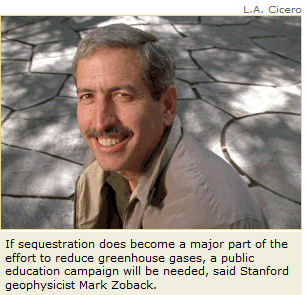|
|
|
|
|
|
|
News & Views item - January 2011 |
![]() Might Extensive CO2 Sequestration Trigger
Temblors? (January 19, 2011)
Might Extensive CO2 Sequestration Trigger
Temblors? (January 19, 2011)
 The
pumping of massive amounts of CO2 into the ground for long-term
storage, carbon sequestration, has been touted as a promising method to reduce
global warming. But now a Stanford University professor of geophysics has
sounded a note of warning.
The
pumping of massive amounts of CO2 into the ground for long-term
storage, carbon sequestration, has been touted as a promising method to reduce
global warming. But now a Stanford University professor of geophysics has
sounded a note of warning.
Mark Zoback, noting that thousands of CO2 injections would be required throughout the planet, suggests that storing massive amounts of the gas could set off small temblors which in turn could trigger seepage back into the atmosphere through cracks appearing in the subterranean reservoirs.
"It is not the shaking an earthquake causes at the surface that creates the hazard in this instance," Professor Zoback says, "It's what it does at depth. It may not take a very big earthquake to damage the seal of an underground reservoir that has been pumped full of carbon dioxide."
He went on to note that the problem in North America, for example, is the result of potential earthquakes because the continent is riddled with ancient faults, "a state of failure equilibrium... So, in the context [of the geological time scale], when we start perturbing the system by changing fluid pressure [as we inject massive amounts of CO2 into the subsurface], we have the potential for activating faults."
Nevertheless, Professor Zoback stressed: "I am not against carbon dioxide sequestration by any means and it certainly has a role. What I am asking people to consider is whether or not it should really be one of the key components of a strategy for reduction of greenhouse gas."
Moving to specifics Professor Zoback noted in talking to Stanford News' Louis Bergeron that there are two sequestration projects already under way, in Norway and Algeria, and so far they appear to be working as planned. But Professor Zoback said 3,400 such projects would be needed worldwide by midcentury to deal with the volume of carbon dioxide that we will be generating: "Finding that many ideal sites around the globe is not impossible, but it is going to be a tremendous challenge. My main concern is to get these geological issues out on the table. I want to get the discussion started."
And in that context the geophysicist brought up the matter of public relations: "If we make a massive commitment to injecting carbon dioxide into subsurface reservoirs and then public concern over the earthquakes shuts it all down, then where are we?"